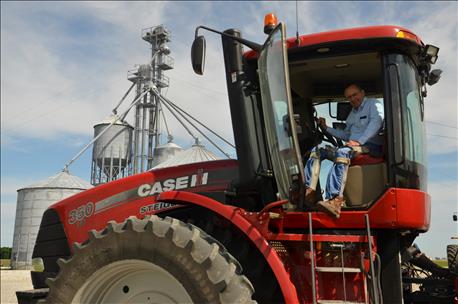
Changing attitudes takes time. Here is an example:
Three decades ago, you would not have read a story about a disabled farmer who was making a go of it on his own in this space. You also wouldn’t have read about a fledgling group that was trying to help people like him. Breaking New Ground was doing just that: breaking stereotypes and plowing new territory so people who suffered disabling injuries could still get the help they needed if they chose to remain in farming.
You wouldn’t have read the story then because some people at that time thought injured people had no business farming. Some people believed efforts to help them were futile, and were best directed elsewhere.

HELPING HAND: Programs like Breaking New Ground, the forerunner of AgrAbility, have helped farmers like Dan Gwin, Linden, find the equipment and support they need to farm successfully.
Thank goodness for two things. First, thank goodness for people like Bill Field, who didn’t believe that philosophy for a minute. Second, thank goodness for current editors at most ag news outlets around the country who believe these people are an important part of agriculture, and that efforts to help them are more than noble — they’re critical to maintaining the character and vivacious spirit of agriculture.
The beginning
Hold up on the reins for a moment. Let’s go back to the 1980s. Field, Extension ag safety specialist at Purdue University, with staff he put together, began a program called Breaking New Ground. They sought out individuals or companies interested in making products that could help those with injuries continue farming. And they began a quest to understand what kind of support besides equipment these people needed.
Breaking New Ground exhibits, always manned by capable staff, began showing up at field days, Extension meetings and farm shows, and the word got around. The program became a clearinghouse for information about disabilities and ways to overcome them, plus a networking opportunity for people with needs and people who thought they could help meet those needs.
Dan Gwin, Linden, a farmer confined to a wheelchair after a farm accident, helped promote Breaking New Ground at the time. He also found ways to continue his farming operation. Gwin was recognized this year as a Master Farmer, not because he overcame injuries, but because in spite of setbacks, he has successfully developed an outstanding, efficient farm operation.
Program today
Breaking New Ground eventually became AgrAbility, still housed at Purdue, but serving people in need nationwide. A few years ago it became a federally funded initiative in the farm bill. Even Congress recognized the value of the program, and how an investment in helping people could return rewards many times greater.
But here is where you come in. Field says the program is up for review this year. All federal programs come up for review and renewal in funding at set intervals. Naturally, Field would like to see the program to remain funded, and for the epicenter of this effort to remain at Purdue, where it began some three decades ago.
If you believe in the program, too, let your elected officials know how you feel. And drop Field a line, too. He can use words of encouragement, like anyone else, and would love to know that Hoosiers appreciate this truly groundbreaking movement that he helped create. You can email Field at [email protected].
About the Author(s)
You May Also Like




